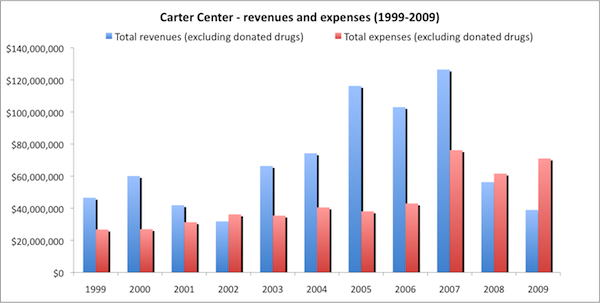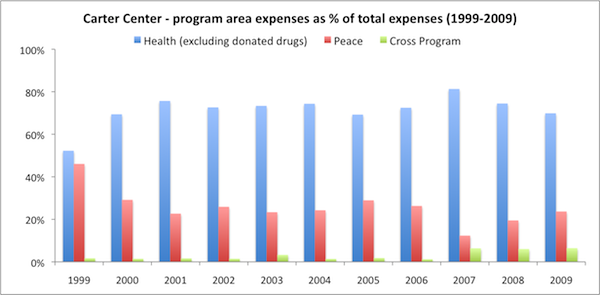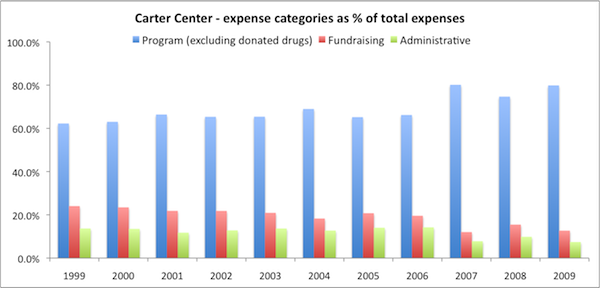In 2016 the Carter Center declined to participate in our review process. See our most recent content on the Carter Center.
About this page
GiveWell aims to find the best giving opportunities we can and recommend them to donors. We tend to put a lot of investigation into the organizations we find most promising, and de-prioritize others based on limited information. When we decide not to prioritize an organization, we try to create a brief writeup of our thoughts on that charity because we want to be as transparent as possible about our reasoning.
The following write-up should be viewed in this context: it explains why we determined that we wouldn't be prioritizing the organization in question as a potential top charity. This write-up should not be taken as a "negative rating" of the charity. Rather, it is our attempt to be as clear as possible about the process by which we came to our top recommendations.
A note on this page's publication date
The last time we examined The Carter Center was in 2009. In our latest open-ended review of charities, we determined that it was unlikely to meet our criteria based on our past examination of it, so we did not revisit it.
We invite all charities that feel they meet our criteria to apply for consideration.
The content we created in 2009 appears below. This content is likely to be no longer fully accurate, both with respect to what it says about The Carter Center and with respect to what it implies about our own views and positions. With that said, we do feel that the takeaways from this examination are sufficient not to prioritize re-opening our investigation of this organization at this time.
Published: July 2009
Summary
The Carter Center is a large, US-based organization that focuses mostly on global health, including neglected tropical diseases.
We believe that The Carter Center is notable because:
- It publicly publishes detailed and regular reports on impact,1 something that distinguishes it from the vast majority of charities we've examined.
- Many of its health programs are proven and cost-effective ways to change lives, addressing diseases that tend to get less attention than others but are still highly debilitating. (Details on its programs follow; many are in our list of priority programs.)
We cannot be confident in The Carter Center's impact because:
- It runs many programs for which we have little or no sense of impact, and on which it provides relatively little information. (Details below.)
- It does not provide the financial breakdowns necessary to determine how much it is allocating to the programs we have more confidence in vs. the programs we have less confidence in (or to confirm that the ones we have more confidence in are indeed running cost-effectively). We have spoken with representatives several times and have repeatedly requested this information.
Earlier in our research process, we believed that The Carter Center was one of the very strongest charities we had seen, and we completed a highly in-depth report on it, which follows. At this point, we have significantly more confidence in our top-rated charities.
Table of Contents
Programs
Note that we have thoroughly assessed the first five programs listed; considerably less information appears to be available on the others.
| Program | Proportion of total expenses | What does it do? | Our confidence in effectiveness | Cost per DALY (what is this?) | What does $100 do? | More |
|---|---|---|---|---|---|---|
| Guinea Worm Eradication Program | ~15-20%2 | Case management, water filtration | Very high | Unknown | Averts 12-25 cases of guinea worm (symptoms) | More |
| River Blindness Program | Unknown | Mass drug administration | Relatively high | $7-$40 | Averts 10-50 years of serious debilitation (blindness, low vision, or irritating skin disease) | More |
| Trachoma Control Program | Unknown | Surgery, drug distribution, hygiene education and water and sanitation improvements. | Moderate | $4-$82 (surgeries); very high or unknown (other components) | Averts 1-30 years of blindness and another 1-30 years of low vision (surgeries); little or unknown (other components) | More |
| Lymphatic Filariasis Elimination Program | Unknown | Mass drug administration | Relatively high | $4.40-$29 | Averts 15-85 total years of lymphedema (swollen limbs) and 25-165 total years of hydrocele (swollen scrotum) | More |
| Schistosomiasis Control Program | Unknown | Mass drug administration | Relatively high | $3.36-$19 | Enables ~29 additional years of school attendance by treated children | More |
| Malaria Control Program | Unknown | Distribution of insecticide-treated bednets | Moderate | $19-$85 | Averts 10-47 malaria episodes (1 in ~320 is fatal) | More |
| Agriculture Program | Unknown | Aims to help farmers increase crop yields | Low | Unknown | Unknown | More |
| Ethiopian Public Health Training Initiative | Unknown | Support for training of health care professionals | Low | Unknown | Unknown | More |
| International Task Force for Disease Eradication | Unknown; likely small3 | Evaluates potential for disease eradication | N/A (outside scope of this report) | N/A (outside scope of this report) | N/A (outside scope of this report) | More |
| Mental Health Program | Unknown | Forums; public outreach; fellowships for journalists | N/A (outside scope of this report) | N/A (outside scope of this report) | N/A (outside scope of this report) | More |
| Peace Programs | ~7% (see next section) | Includes election monitoring and conflict resolution | N/A (outside scope of this report) | N/A (outside scope of this report) | N/A (outside scope of this report) | More |
Financials/other
The charts below provide a summary of The Carter Center's finances. All data is from publicly available annual reports.4 All data excludes donated drugs. For more detail, see our calculations.
See also, general information about our financial metrics.
Revenue and expense growth (about this metric): The Carter Center's revenues and expenses have risen overall over the past 10 years, with revenues generally staying substantially ahead of expenses until 2008.

Assets-to-expenses ratio (about this metric): The Carter Center has maintained an assets-to-expenses ratio of between 5:1 and 10:1; it currently has enough assets to continue operating at current levels for the next 5 years if revenue were to cease. This is a relatively high level of reserves, and leads us to wonder about the extent to which additional donations would translate into expansion of activities. (See our unanswered questions below.)

Expenses by program area (about this metric): Between 2000 and 2009, the Carter Center spent between about 70 and 80% of its program budget on its health programs each year. We do not have information on what percentage of the health budget was spent on each of its health programs.

Expenses by IRS-reported category (about this metric): the Carter Center maintains a reasonable "overhead ratio", spending approximately 60-80% of its budget on program expenses.

Unanswered questions
The Carter Center stands out for its transparency and its effectiveness in fighting damaging, but often-overlooked diseases. However, we have several unanswered questions and concerns:
- Budget information. Although the Carter Center makes its official financial statements available, it does not appear to disclose the breakdown of its expenses by project or by disease control program. We therefore have very little sense of the weight of its stronger programs as opposed to programs we have less confidence in.
- Programs on which limited information appears available. The Carter Center appears to have little information available on the effectiveness and progress of its Malaria Control Program, Ethiopian Public Health Training Initiative, and Agriculture Program. In addition, it appears to provide only partial monitoring (in terms of progress in reducing disease prevalence) for its Onchocerciasis Control Program and Trachoma Control Program. More information about these programs might increase our confidence; more disclosure of budget information (see point above) would clarify for us how important a role these programs play.
- Lack of external evaluations. All effectiveness data is self-reported. (It's worth noting that in our experience, external evaluations are extremely rare; the Carter Center's evidence for effectiveness stands out from that of other charities we've investigated.)
- High assets to expenses ratio may indicate that the Carter Center faces bottlenecks to expanding its activities other than money. We have little sense of how a rise in donations would impact the Carter Center's work.
- Partnerships and The Carter Center's role. The Carter Center works in partnership with other nonprofit organizations, local governments, and initiatives that combine the efforts of multiple actors (such as the African Program for Onchocerciasis Control). Little information appears available to clarify the precise role that The Carter Center plays (relative to other partners) in each area.
Sources
- Carter Center. Annual Reports for:
- Carter Center. Website:
- Health program news & publications. http://cartercenter.org/news/publications/health/index.html (accessed April 19, 2010). Archived by WebCite® at http://www.webcitation.org/5p6l27HbN.
- Gates Foundation. The Carter Center. http://www.gatesfoundation.org/Grants-2000/Pages/The-Carter-Center-OPP1… (accessed 4/19/2010). Archived by WebCite® at http://www.webcitation.org/5p6nBEX9q.
- GiveWell. Carter Center financial data analysis.
- 1
Carter Center, "Health Program News & Publications." The individual program reports linked on this page go into detail on what the Carter Center's impact reports show.
- 2
- A Carter Center representative, Phil Wise, estimated the annual cost of the program at $10-15 million. Phil Wise, phone conversation with GiveWell, February 2, 2009.
- The Carter Center's total expenses (excluding donated drugs) for 2009 were $71 million. Carter Center, "Annual Report (2009)."
- 3
In 2000, the Gates Foundation awarded $741,000 over 3 years to "reactivate" this task force. Gates Foundation, "The Carter Center."
- 4
Carter Center, "Annual Reports (1999-2009)."
